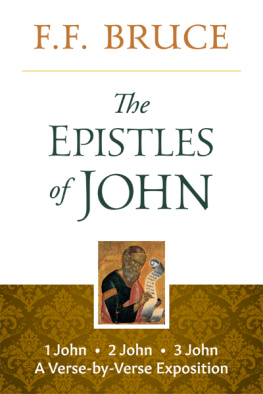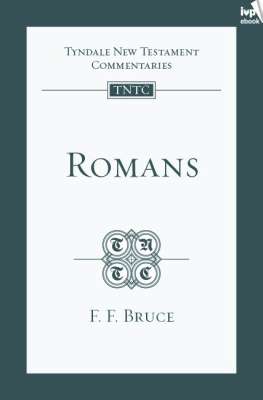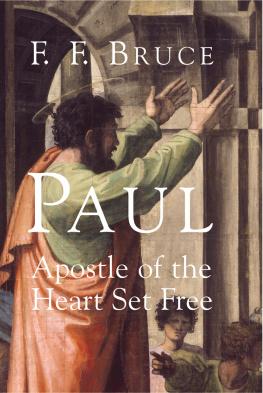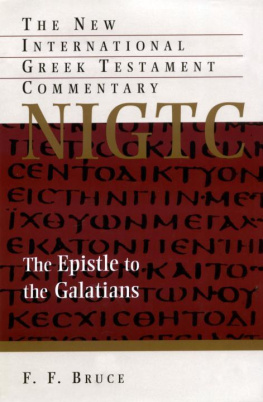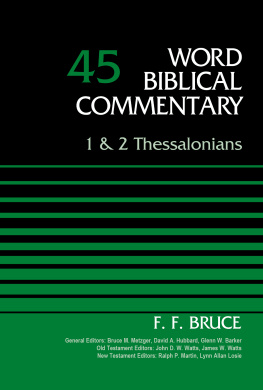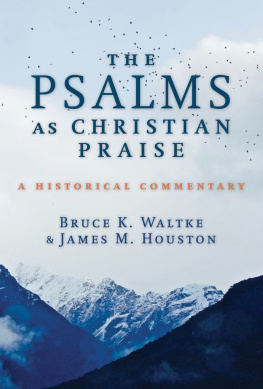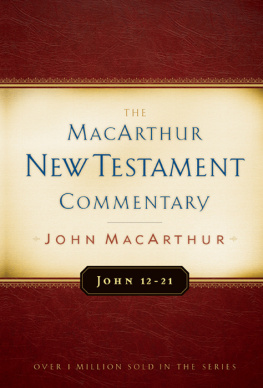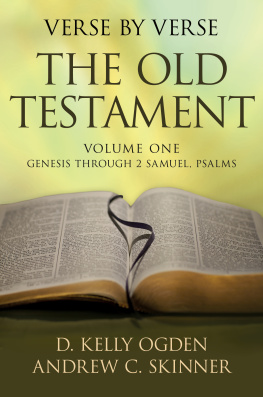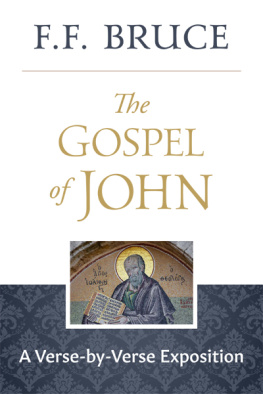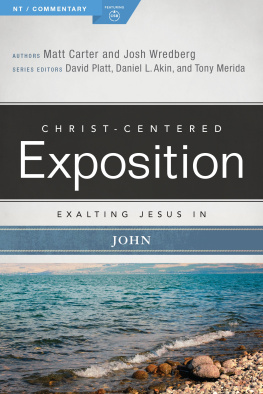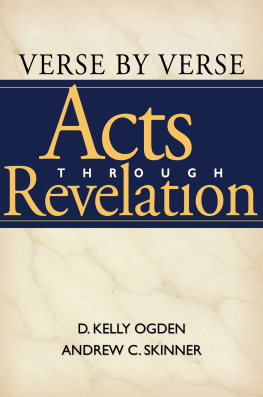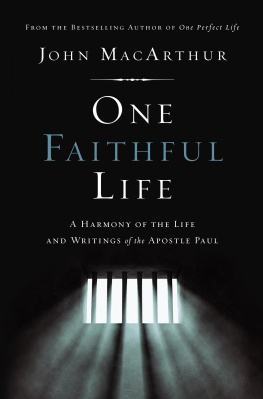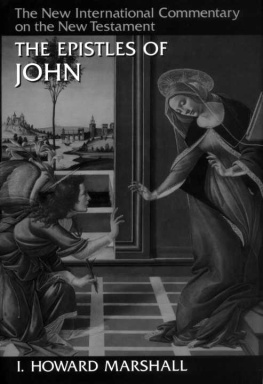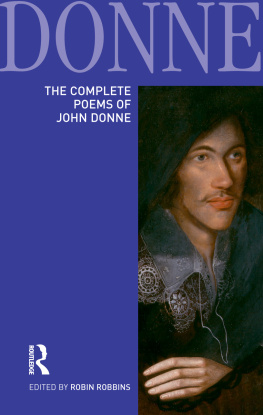F. F. BRUCE
M.A. (Cambridge), D.D. (Aberdeen)
Rylands Professor of Biblical Criticism and Exegesis in the University of Manchester
PUBLISHERS INTRODUCTION
T HE EPISTLES TO JOHN WERE WRITTEN to Asian Christians at the end of the first century to encourage them in the face of false teachings and to assure them that they were following the truth of Christ. Johns clearly stated purpose is that his readers may know that ye have eternal life (1 John 5:13) and that ye also may have fellowship with us: yea, and our fellowship is with the Father, and with his Son Jesus Christ and... that your joy may be fulfilled. (1 John 1:3-4).
The temptation to conform the gospel to current fashions of thought is as real today as it was in the time of John. For instance, Bruce explains that
Worldliness... does not lie in things we do or in places we frequent; it lies in the human heart.... It may manifest itself in petty but soul-stunting ambitions like keeping up with the Joneses; it may manifest itself in unthinking acquiescence in current policies of monstrous malignity, as when too many Christians in Nazi Germany found it possible to go along with (or close their eyes to) their governments genocidal treatment of the Jews. Worldliness of this sort is not that which has usually been denounced by popular pietism.
Originally written as a series of magazine articles for The Witness , F.F. Bruces exposition and introduction to the Epistles of John is as relevant today as when it was written more than fifty years ago. His insights speak sharply but lovingly.
- Why does Christian practice so often fall short of Christian profession?
- The one effective antidote to worldliness is to have ones heart so filled with the Fathers love that it has no room for any love that is incompatible with that.
- Orthodoxy of doctrine is no substitute for righteousness of life.
- If my reputation, my public image, matters more to me than the glory of God or the well-being of my fellows, the pretentiousness of life has become the object of my idol-worship.
- The love of God displayed in His people is the strongest apologetic that God has in the world.
Drawing on his years of scholarship, Bruce presents the meaning of the epistles in a straightforward and understandable way, touching only lightly on textual, critical, and linguistic questions. An excellent guide, said Christianity Today . Bruce speaks up with grace and clarity on the Johannine Epistles, said The Christian Century . And an Amazon reviewer added, I found that I have a much fuller understanding of the Johannine epistles as a whole and am able to better make sense of them as a result of this book.
* * * * *
The Epistles of John is published under the Kingsley Books imprint of F.F. Bruce Copyright International.
When Robert Hicks, a British book publisher, realized that many of the works of F.F. Bruce were not readily available, he wanted to correct that situation. Of the nearly 60 books and hundreds of magazine articles written by the Dean of Evangelical Scholarship, Robert felt many of those not in print could be presented in a visually appealing way for the modern reader.
After receiving the support of F.F. Bruces daughter, Sheila Lukabyo, Robert enlisted the help of Larry Stone, an American publisher. Together they contacted nearly twenty of F.F. Bruces publishers. Some of Bruces books are being reformatted into printed booklets suitable for evangelism and Bible study in universities and in church groups. Many of Bruces printed books as well as collections of articles never before appearing in book form are being made available as reasonably-priced ebooks that can be easily distributed around the world.
The purpose of F.F. Bruce Copyright International is to encourage an understanding of Professor Bruces teaching on the Scripture, to encourage his spirit of humility in approaching the Bible, and encourage academic scholarship among todays evangelical students and leaders.
For the latest information on the availability of ebooks and printed books by F.F. Bruce and his friends, see www.ffbruce.com .
PREFACE
T HE substance of this commentary appeared in twenty-four installments in The Witness during 1967 and 1968. It is mainly due to the friendly insistence of the Editor of The Witness, Mr. G. C. D. Howley, that the work was undertaken in the first instance.
Like my exposition of Ephesians, these studies are intended chiefly for the general Christian reader who is interested in serious Bible study, not for the professional or specialist student. Textual, linguistic and other critical questions have been touched on lightly; the main aim has been to bring out the meaning and message of the three Epistles. The professional student may, however, find some help in a number of the notes which have been added for the publication of the work in book form, especially in those which provide bibliographical information on matters of exegetical importance.
The Bible text on which the exposition is based is the Revised Version of 1881, since that is the most literal of all the standard renderings of the Greek text. Other versions, however, have been freely utilized.
August, 1970 F.F.B.
PRINCIPAL ABBREVIATIONS
| ASV | American Standard Version |
| BJRL | Bulletin of the John Rylands Library (Manchester) |
| CSEL | Corpus Scriptorum Ecclesiasticorum Latinorum |
| Hist. Eccl. | Ecclesiastical History (Eusebius) |
| JBL | Journal of Biblical Literature |
| JTS | Journal of Theological Studies |
| KJV | King James Version (Authorized Version) |
| LXX | Septuagint (Greek Old Testament) |
| NEB | New English Bible |
| NT | New Testament |
| NTS | New Testament Studies |
| OT | Old Testament |
| RSV | Revised Standard Version |
| RV | Revised Version |
| TDNT | Theological Dictionary of the New Testament , edited by G. Kittel and G. Friedrich, English translation by G. W. Bromiley (Eerdmans, Grand Rapids, 1964-) |
| TEV | Todays English Version (Good News for Modern Man) |
| TU | Texte und Untersuchungen |
| ZTK | Zeitschrift fr Theologie und Kirche |
GENERAL INTRODUCTION
I. BACKGROUND AND OCCASION OF THE THREE EPISTLES
T HE ROMAN PROVINCE OF ASIA OCCUPIED roughly the western third of the peninsula which we call Asia Minor. The Romans gave it the name of Asia because it was the first territory on the continent of Asia to come under the direct control of the Roman state. For a century and a half before its incorporation in the Roman Empire, this territory had constituted the kingdom of Pergamum, whose rulers were friends and allies of Rome. When the last king of Pergamum died, in 133 BC, he bequeathed his realm to the Roman senate and people, and after deliberation they decided to accept the bequest. After reorganization as a Roman province, it was governed by a senior ex-magistrate called a proconsul, who was appointed by the senate, normally for one year. The province is therefore referred to sometimes as proconsular Asia. To begin with, the proconsuls seat of government was at Pergamum, the capital of the former kingdom, but later it was moved to Ephesus, and there it remained throughout New Testament times. Asia was regarded as the wealthiest of the Roman provinces; its cities had been centers of Greek culture for many centuries.

